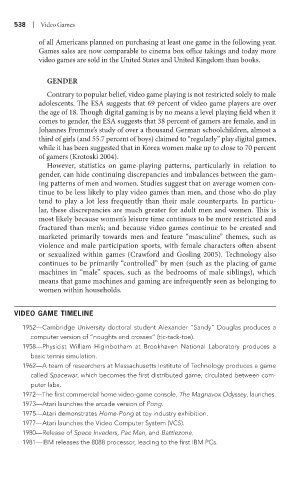Page 559 - Battleground The Media Volume 1 and 2
P. 559
| V deo Games
of all Americans planned on purchasing at least one game in the following year.
Games sales are now comparable to cinema box office takings and today more
video games are sold in the United States and United Kingdom than books.
gEnDEr
Contrary to popular belief, video game playing is not restricted solely to male
adolescents. The ESA suggests that 69 percent of video game players are over
the age of 18. Though digital gaming is by no means a level playing field when it
comes to gender, the ESA suggests that 38 percent of gamers are female, and in
Johannes Fromme’s study of over a thousand German schoolchildren, almost a
third of girls (and 55.7 percent of boys) claimed to “regularly” play digital games,
while it has been suggested that in Korea women make up to close to 70 percent
of gamers (Krotoski 2004).
However, statistics on game-playing patterns, particularly in relation to
gender, can hide continuing discrepancies and imbalances between the gam-
ing patterns of men and women. Studies suggest that on average women con-
tinue to be less likely to play video games than men, and those who do play
tend to play a lot less frequently than their male counterparts. In particu-
lar, these discrepancies are much greater for adult men and women. This is
most likely because women’s leisure time continues to be more restricted and
fractured than men’s; and because video games continue to be created and
marketed primarily towards men and feature “masculine” themes, such as
violence and male participation sports, with female characters often absent
or sexualized within games (Crawford and Gosling 2005). Technology also
continues to be primarily “controlled” by men (such as the placing of game
machines in “male” spaces, such as the bedrooms of male siblings), which
means that game machines and gaming are infrequently seen as belonging to
women within households.
Video gaMe tiMeline
1952—Cambridge University doctoral student Alexander “Sandy” Douglas produces a
computer version of “noughts and crosses” (tic-tack-toe).
1958—Physicist William Higinbotham at Brookhaven National Laboratory produces a
basic tennis simulation.
1962—A team of researchers at Massachusetts Institute of Technology produces a game
called Spacewar, which becomes the first distributed game, circulated between com-
puter labs.
1972—The first commercial home video-game console, The Magnavox Odyssey, launches.
1973—Atari launches the arcade version of Pong.
1975—Atari demonstrates Home-Pong at toy industry exhibition.
1977—Atari launches the Video Computer System (VCS).
1980—Release of Space Invaders, Pac Man, and Battlezone.
1981—IBM releases the 8088 processor, leading to the first IBM PCs.

